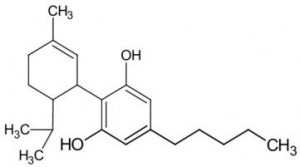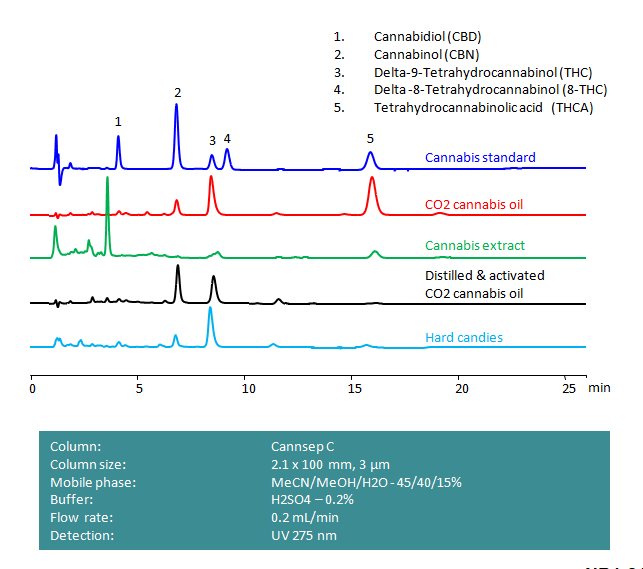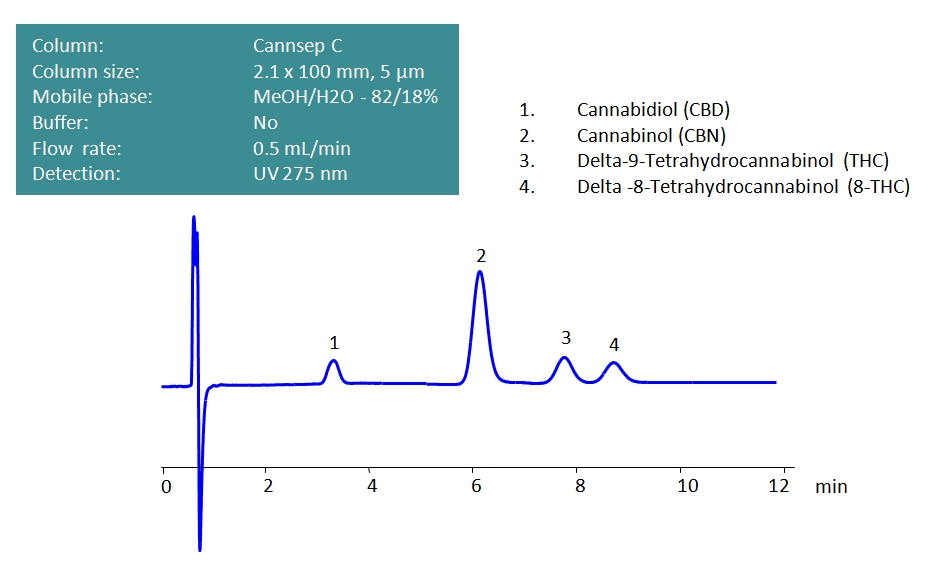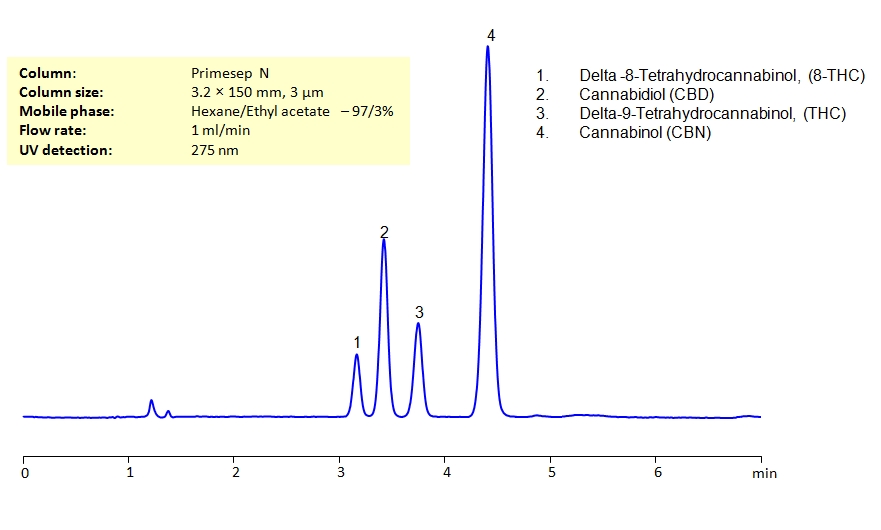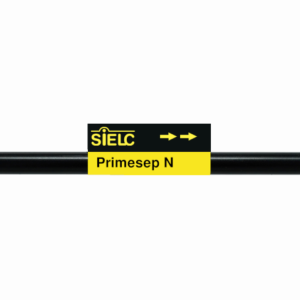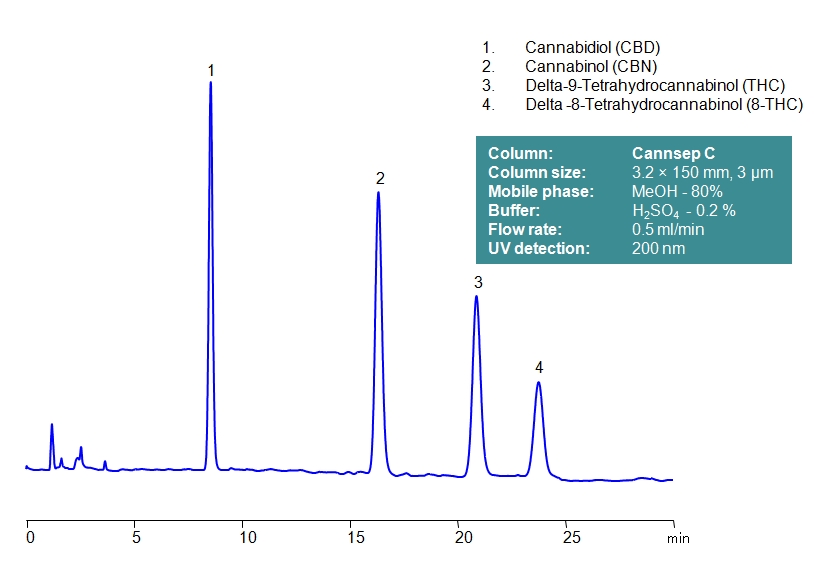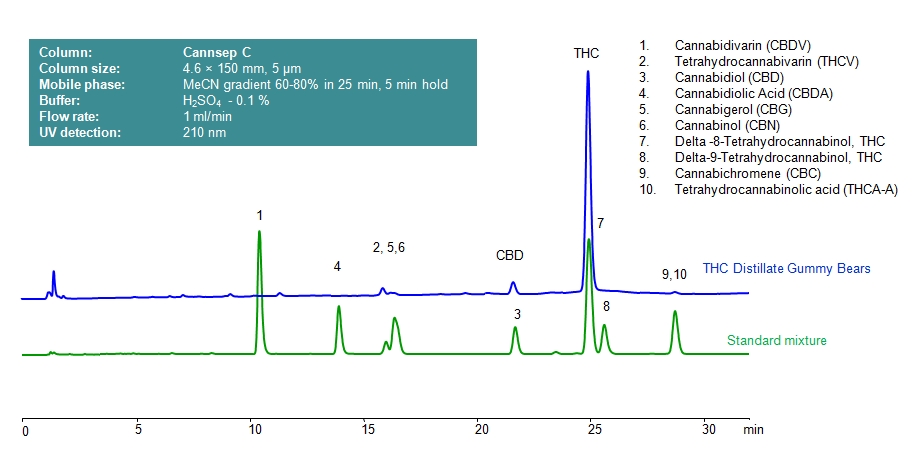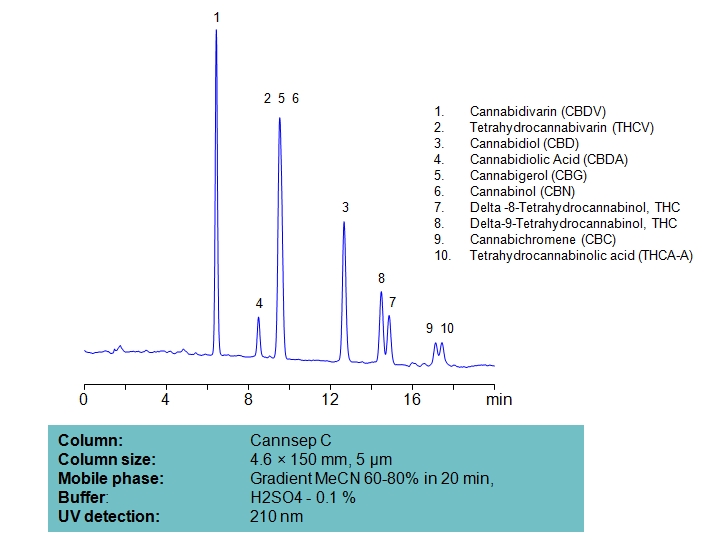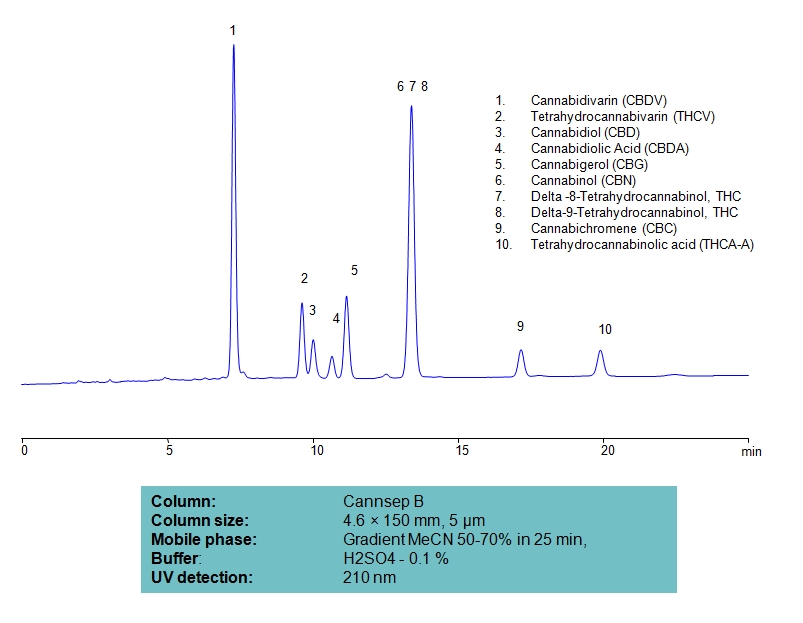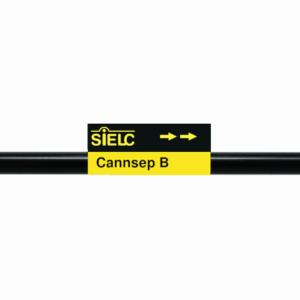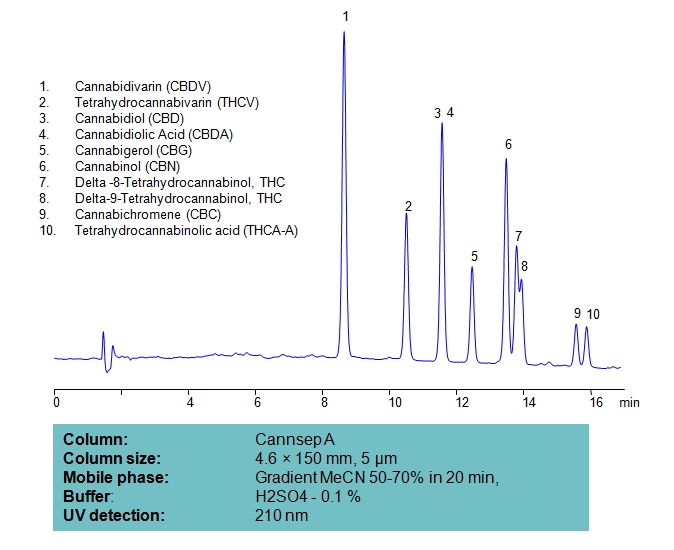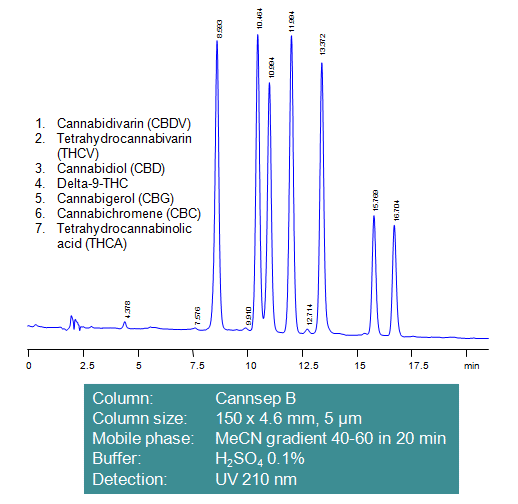| CAS Number | 3556-78-3 |
|---|---|
| Molecular Formula | C21H30O2 |
| Molecular Weight | 314.469 |
| InChI Key | QHMBSVQNZZTUGM-ZWKOTPCHSA-N |
| LogP | 6.5 |
| Synonyms |
|
Applications:
HPLC Determination of CBD, CBN, THC, 8-THC and THCA on Cannsep C Column
June 14, 2021
HPLC Method for Cannabidiol (CBD), Cannabinol (CBN), Tetrahydrocannabinol (THC), Delta-8-Tetrahydrocannabinol (8-THC), Delta-9-Tetrahydrocannabinol (THC), Tetrahydrocannabinolic acid (THCA-A) on Cannsep C by SIELC Technologies
High Performance Liquid Chromatography (HPLC) Method for Analysis of CBD, CBN, THC, 8-THC and THCA.
Cannabidiol (CBD) is a phytocannabinoid with the chemical formula C21H30O2. It is used in a variety of ways. It’s only confirmed medical use is as epilepsy medication. It may help with pain, sleep, and addiction as an alternative to opioids, but due to limited clinical evidence, it’s regulations are dependent on the state. It is advised against using it during pregnancy due to unknown effects on fetal and infant development.
Cannabinol (CBN) is a mildly psychoactive phytocannabinoid with the chemical formula C21H26O2. It was the first cannabinoid to be isolated from cannabis in the late 1800s. It is legal in the United States as long as the THC concentration is 0.3% or less.
Delta-9-Tetrahydrocannabinol, also known as delta-9-THC and Δ9-THC, or simply THC, is the principal psychoactive constituent of Cannabis with the chemical formula C21H30O2. In pharmaceutical contexts, it is referred to as dronabinol and is used un nabiximols, which helps alleviate neuropathic pain, spasticity, overactive bladder, and more. Medical use of THC is allowed in the majority of the states in the United States of America, with less than half having it be legal for recreational use.
Delta-8-Tetrahydrocannabinol, also known as delta-8-THC and Δ8-THC, is a sychoactive cannabinoid with the chemical formula C21H30O2. It is less potent than delta-9-THC, it works in a similar way by binding to cannabinoid receptors in the brain. It’s legality is dependent on the state.
Tetrahydrocannabinolic acid (THCA), also known as conjugate base tetrahydrocannabinolate, is a precursor of Tetrahydrocannabinol with the chemical formula C22H30O4. Findings in regards to it being anything besides the THC precursor are limited, nor is it scheduled at the federal level in the United States, but it may be considered an analog of THC, leading to a risk if possessing or selling it.
Δ8-THC, Δ9-THC, CBD, THCA and CBN are cannabinoids found in Cannabis plants. They have some medical uses among which is the prevention of nausea and vomiting caused by some cancer medications. They can be separated using HPLC on a reverse-phase Cannsep C column using a mobile phase consisting of methanol (MeOH), Acetonitrile (MeCN, ACN), and water with sulfuric acid (H2SO4) as buffer and UV detected at 210nm.
| Column | Cannsep C, 2.1 x 100 mm, 3 µm, 100 A, dual ended |
| Mobile Phase | MeCN/MeOH/H2O – 45/40/15% |
| Buffer | H2SO4 – 0.2% |
| Flow Rate | 0.2 ml/min |
| Detection | UV, 200 nm |
| Class of Compounds | Drug, Hydrophilic, Ionizable, Supplements |
| Analyzing Compounds | Cannabidiol (CBD), Cannabinol (CBN), Tetrahydrocannabinol (THC), Delta-8-Tetrahydrocannabinol (8-THC), Delta-9-Tetrahydrocannabinol (THC), Tetrahydrocannabinolic acid (THCA-A) |
Application Column
Cannsep C
Column Diameter: 2.1 mm
Column Length: 100 mm
Particle Size: 3 µm
Pore Size: 100 A
Column options: dual ended
Cannabinol (CBN)
Delta-8-Tetrahydrocannabinol (8-THC)
Delta-9-Tetrahydrocannabinol (THC)
Tetrahydrocannabinol (THC)
Tetrahydrocannabinolic acid (THCA-A)

HPLC Determination of CBD, CBN, THC in 1:1 Citrus Lime Tonic on Canncep C Column
May 3, 2021
HPLC Method for Cannabidiol (CBD), Cannabinol (CBN), Delta-9-Tetrahydrocannabinol (THC) on Cannsep C by SIELC Technologies
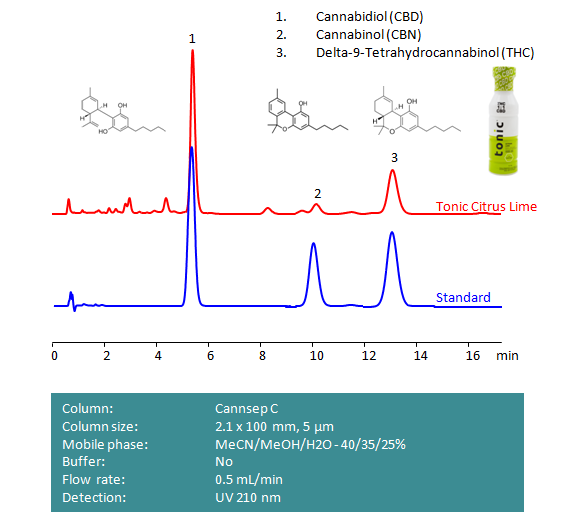
High Performance Liquid Chromatography (HPLC) Method for Analysis of CBD, CBN, delta-9 THC, delta-8 THC
Cannabidiol (CBD), cannabinol (CBN), and delta-9-Tetrahydrocannabinol (THC) are three of the most active cannabinoids in cannabis.
Delta-9-Tetrahydrocannabinol, also known as delta-9-THC and Δ9-THC, or simply THC, is the principal psychoactive constituent of Cannabis with the chemical formula C21H30O2. In pharmaceutical contexts, it is referred to as dronabinol and is used un nabiximols, which helps alleviate neuropathic pain, spasticity, overactive bladder, and more. Medical use of THC is allowed in the majority of the states in the United States of America, with less than half having it be legal for recreational use.
Cannabidiol (CBD) is a phytocannabinoid with the chemical formula C21H30O2. It is used in a variety of ways. It’s only confirmed medical use is as epilepsy medication. It may help with pain, sleep, and addiction as an alternative to opioids, but due to limited clinical evidence, it’s regulations are dependent on the state. It is advised against using it during pregnancy due to unknown effects on fetal and infant development.
Cannabinol (CBN) is a mildly psychoactive phytocannabinoid with the chemical formula C21H26O2. It was the first cannabinoid to be isolated from cannabis in the late 1800s. It is legal in the United States as long as the THC concentration is 0.3% or less. Little research has been done into it’s potential health benefits.
These cannabinoids can be detected in the low UV regime. Using a Cannsep C reverse-phase column and a mobile phase consisting of water, methanol (MeOH) and acetonitrile (MeCN) with a sulfuric acid (H2SO4) buffer, CBD, CBN, and THC can be separated, measured, and analyzed. This analysis method can be UV detected at 210 nm with high resolution, even in real-world samples.
| Column | Cannsep C, 2.1 x 100 mm, 5 µm, 100 A, dual ended |
| Mobile Phase | MeCN/MeOH/H2O – 40/35/25% |
| Buffer | No |
| Flow Rate | 0.5 ml/min |
| Detection | UV, 210 nm |
| Class of Compounds | Drug, Hydrophilic, Ionizable, Supplements |
| Analyzing Compounds | Cannabidiol (CBD), Cannabinol (CBN), Delta-9-Tetrahydrocannabinol (THC) |
Application Column
Cannsep C
Column Diameter: 2.1 mm
Column Length: 100 mm
Particle Size: 5 µm
Pore Size: 100 A
Column options: dual ended
Cannabinol (CBN)
Delta-9-Tetrahydrocannabinol (THC)

HPLC Separation of CBD, CBN, delta-9 THC, delta-8 THC on Cannsep C Column
April 30, 2021
HPLC Method for Cannabidiol (CBD), Cannabinol (CBN), Delta-8-Tetrahydrocannabinol (8-THC), Delta-9-Tetrahydrocannabinol (THC) on Cannsep C by SIELC Technologies
High Performance Liquid Chromatography (HPLC) Method for Analysis of CBD, CBN, delta-9 THC, delta-8 THC
Delta-8-Tetrahydrocannabinol, also known as delta-8-THC and Δ8-THC, is a sychoactive cannabinoid with the chemical formula C21H30O2. It is less potent than delta-9-THC, it works in a similar way by binding to cannabinoid receptors in the brain. It’s legality is dependent on the state. Delta-9-Tetrahydrocannabinol, also known as delta-9-THC and Δ9-THC, or simply THC, is the principal psychoactive constituent of Cannabis with the chemical formula C21H30O2. In pharmaceutical contexts, it is referred to as dronabinol and is used un nabiximols, which helps alleviate neuropathic pain, spasticity, overactive bladder, and more. Medical use of THC is allowed in the majority of the states in the United States of America, with less than half having it be legal for recreational use.
Cannabidiol (CBD) is a phytocannabinoid with the chemical formula C21H30O2. It is used in a variety of ways. It’s only confirmed medical use is as epilepsy medication. It may help with pain, sleep, and addiction as an alternative to opioids, but due to limited clinical evidence, it’s regulations are dependent on the state. It is advised against using it during pregnancy due to unknown effects on fetal and infant development.
Cannabinol (CBN) is a mildly psychoactive phytocannabinoid with the chemical formula C21H26O2. It was the first cannabinoid to be isolated from cannabis in the late 1800s. It is legal in the United States as long as the THC concentration is 0.3% or less. Little research has been done into it’s potential health benefits.
These cannabinoids can be detected in the low UV regime. Using a Cannsep C reverse-phase column and a mobile phase consisting of water and methanol (MeOH) with no buffer, CBD, CBN, delta-9 THC, and delta-8 THC can be separated, measured, and analyzed. This analysis method can be UV detected at 275 nm with high resolution.
| Column | Cannsep C, 2.1 x 100 mm, 5 µm, 100 A, dual ended |
| Mobile Phase | MeOH/H2O – 82/18% |
| Buffer | No |
| Flow Rate | 0.5 ml/min |
| Detection | UV, 275 nm |
| Class of Compounds | Drug, Hydrophilic, Ionizable, Supplements |
| Analyzing Compounds | Cannabidiol (CBD), Cannabinol (CBN), Delta-8-Tetrahydrocannabinol (8-THC), Delta-9-Tetrahydrocannabinol (THC) |
Application Column
Cannsep C
Column Diameter: 2.1 mm
Column Length: 100 mm
Particle Size: 5 µm
Pore Size: 100 A
Column options: dual ended
Cannabinol (CBN)
Delta-8-Tetrahydrocannabinol (8-THC)
Delta-9-Tetrahydrocannabinol (THC)

HPLC Determination of Δ8-THC, CBD, Δ9-THC, and CBN on Primesep N Column
May 15, 2020
HPLC Method for Cannabidiol (CBD), Cannabinol (CBN), Delta-8-Tetrahydrocannabinol (8-THC), Delta-9-Tetrahydrocannabinol (THC) on Primesep N by SIELC Technologies
High Performance Liquid Chromatography (HPLC) Method for Analysis of Cannabidiol (CBD), Cannabinol (CBN), Delta-8-Tetrahydrocannabinol (8-THC), Delta-9-Tetrahydrocannabinol (THC).
Δ8-THC, Δ9-THC, CBD and CBN are cannabinoids found in Cannabis plants. They have some medical uses among which is the prevention of nausea and vomiting caused by some cancer medications. THC has psychoactive effects, while CBD does not.
They can be separated using HPLC on a normal-phase Primesep N column using a mobile phase consisting of hexane and ethyl acetate without the need for a buffer with UV detection at 275nm.
| Column | Primesep N, 4.6 x 150 mm, 3 µm, 100 A, dual ended |
| Mobile Phase | Hexane/Ethyl Acetate – 97/3% |
| Buffer | No |
| Flow Rate | 1.0 ml/min |
| Detection | UV, 275 nm |
| Class of Compounds |
Drug, Hydrophilic, Ionizable, Supplements |
| Analyzing Compounds | Cannabidiol (CBD), Cannabinol (CBN), Delta-8-Tetrahydrocannabinol (8-THC), Delta-9-Tetrahydrocannabinol (THC) |
Application Column
Primesep N
Column Diameter: 4.6 mm
Column Length: 150 mm
Particle Size: 3 µm
Pore Size: 100 A
Column options: dual ended
Cannabinol (CBN)
Delta-8-Tetrahydrocannabinol (8-THC)
Delta-9-Tetrahydrocannabinol (THC)

HPLC Determination of CBD, CBN, Δ9-THC, Δ8-THC on Cannsep C Column
May 14, 2020
HPLC Method for Cannabidiol (CBD), Cannabinol (CBN), Delta-8-Tetrahydrocannabinol (8-THC), Delta-9-Tetrahydrocannabinol (THC) on Cannsep C by SIELC Technologies
High Performance Liquid Chromatography (HPLC) Method for Analysis of Cannabidiol (CBD), Cannabinol (CBN), Delta-8-Tetrahydrocannabinol (8-THC), Delta-9-Tetrahydrocannabinol (THC).
Δ8-THC, Δ9-THC, CBD and CBN are cannabinoids found in Cannabis plants. They have some medical uses among which is the prevention of nausea and vomiting caused by some cancer medications. THC has psychoactive effects, while CBD does not.
They can be separated using HPLC on a reverse-phase Cannsep C column using a mobile phase consisting of methanol (MeOH) and water with sulfuric acid (H2SO4) as buffer and UV detected at 200nm.
| Column | Cannsep C, 3.2 x 150 mm, 3 µm, 100 A, dual ended |
| Mobile Phase | MeOH -80%, |
| Buffer | H2SO4 – 0.2% |
| Flow Rate | 0.5 ml/min |
| Detection | UV, 200 nm |
| Class of Compounds |
Drug, Hydrophilic, Ionizable, Supplements |
| Analyzing Compounds | Cannabidiol (CBD), Cannabinol (CBN), Delta-8-Tetrahydrocannabinol (8-THC), Delta-9-Tetrahydrocannabinol (THC) |
Application Column
Cannsep C
Column Diameter: 3.2 mm
Column Length: 150 mm
Particle Size: 3 µm
Pore Size: 100 A
Column options: dual ended
Cannabinol (CBN)
Delta-8-Tetrahydrocannabinol (8-THC)
Delta-9-Tetrahydrocannabinol (THC)

HPLC Determination of THC in THC Infused Gummy Bear on Cannsep C Column
January 24, 2020
HPLC Method for Delta-9-Tetrahydrocannabinol (THC), Tetrahydrocannabinol (THC), Cannabidiol (CBD), Cannabidivarin (CBDV), Tetrahydrocannabivarin (THCV), Cannabidiolic acid (CBDA), Cannabigerol (CBG), Cannabinol (CBN), Delta-8-Tetrahydrocannabinol (8-THC), Cannabichromene (CBC), Tetrahydrocannabinolic acid (THCA-A) on Cannsep C by SIELC Technologies
High Performance Liquid Chromatography (HPLC) Method for Analysis of Delta-9-Tetrahydrocannabinol (THC), Tetrahydrocannabinol (THC), Cannabidiol (CBD), Cannabidivarin (CBDV), Tetrahydrocannabivarin (THCV), Cannabidiolic acid (CBDA), Cannabigerol (CBG), Cannabinol (CBN), Delta-8-Tetrahydrocannabinol (8-THC), Cannabichromene (CBC), Tetrahydrocannabinolic acid (THCA-A).
Cannabidivarin (CBDV) is a non-intoxicating psychoactive cannabinoid with the chemical formula C19H26O2. Due to it demonstrating anticonvulsive properties, it is actively in Phase-2 trials for adult epilepsy, childhood epilepsy, and for Prader-Willi Syndrome.
Tetrahydrocannabivarin (THCV, THV) is a cannabinoid receptor type 1 antagonist with the chemical formula C19H26O2. It is prevalent in certain strains of Cannabis in central Asia and southern Africa. It is currently being researched as a potential treatment for obesity-associated glucose intolerances. It is also said to reduce appetite and have energizing effects.
Cannabidiol (CBD) is a phytocannabinoid with the chemical formula C21H30O2. It is used in a variety of ways. It’s only confirmed medical use is as epilepsy medication. It may help with pain, sleep, and addiction as an alternative to opioids, but due to limited clinical evidence, it’s regulations are dependent on the state. It is advised against using it during pregnancy due to unknown effects on fetal and infant development.
Cannabidiolic Acid (CBDA) is a precursor to Cannabidiol with the chemical formula C22H30O4. Research suggests that it might have anti-inflammatory, anti-emetic, anti-convulsant, and anti-carcinogenic properties, but not enough research has been done into it for it to be used as widely as other cannabinoids and the like.
Cannabigerol (CBG) is a non-psychoactive cannabinoid with the chemical formula C21H32O2. It is a minor constituent of cannabis. CBG that is derrived from marijuana is illegal, while CBG derived from hemp is legal as long as the THC content of hemp is less than 0.3% of dry weight. It was sold illegally by certain companies under unproven claims of being treatment against the COVID-19 virus and inflammation.
Cannabinol (CBN) is a mildly psychoactive phytocannabinoid with the chemical formula C21H26O2. It was the first cannabinoid to be isolated from cannabis in the late 1800s. It is legal in the United States as long as the THC concentration is 0.3% or less.
Delta-8-Tetrahydrocannabinol, also known as delta-8-THC and Δ8-THC, is a sychoactive cannabinoid with the chemical formula C21H30O2. It is less potent than delta-9-THC, it works in a similar way by binding to cannabinoid receptors in the brain. It’s legality is dependent on the state.
Delta-9-Tetrahydrocannabinol, also known as delta-9-THC and Δ9-THC, or simply THC, is the principal psychoactive constituent of Cannabis with the chemical formula C21H30O2. In pharmaceutical contexts, it is referred to as dronabinol and is used un nabiximols, which helps alleviate neuropathic pain, spasticity, overactive bladder, and more. Medical use of THC is allowed in the majority of the states in the United States of America, with less than half having it be legal for recreational use.
Cannabichromene (CBC), also known as cannabichrome, cannanbichromene, pentylcannabichromene and cannabinochromene is a phytocannabinoid with the chemical formula C21H30O2. Research suggests that it might have anti-inflammatory, anti-emetic, anti-convulsant, and anti-carcinogenic properties, but not enough research has been done into it for it to be used as widely as other cannabinoids and the like.
Tetrahydrocannabinolic acid (THCA), also known as conjugate base tetrahydrocannabinolate, is a precursor of Tetrahydrocannabinol with the chemical formula C22H30O4. Findings in regards to it being anything besides the THC precursor are limited, nor is it scheduled at the federal level in the United States, but it may be considered an analog of THC, leading to a risk if possessing or selling it.
Delta-9-Tetrahydrocannabinol (THC), Tetrahydrocannabinol (THC), Cannabidiol (CBD), Cannabidivarin (CBDV), Tetrahydrocannabivarin (THCV), Cannabidiolic acid (CBDA), Cannabigerol (CBG), Cannabinol (CBN), Delta-8-Tetrahydrocannabinol (8-THC), Cannabichromene (CBC), Tetrahydrocannabinolic acid (THCA-A) can be retained and analyzed using the Cannsep C stationary phase column. The analysis utilizes an isocratic method with a simple mobile phase consisting of water and acetonitrile (MeCN) with a sulfuric acid buffer. Detection is performed using UV.
| Column | Cannsep C, 4.6 x 150 mm, 5 µm, 100 A, dual ended |
| Mobile Phase | Gradient MeCN 60-80%, 25 min, 5 min hold |
| Buffer | H2SO4 – 0.1% |
| Flow Rate | 1.0 ml/min |
| Detection | UV, 210 nm |
| Class of Compounds |
Drug, Hydrophilic, Ionizable, Supplements |
| Analyzing Compounds | Delta-9-Tetrahydrocannabinol (THC), Tetrahydrocannabinol (THC), Cannabidiol (CBD), Cannabidivarin (CBDV), Tetrahydrocannabivarin (THCV), Cannabidiolic acid (CBDA), Cannabigerol (CBG), Cannabinol (CBN), Delta-8-Tetrahydrocannabinol (8-THC), Cannabichromene (CBC), Tetrahydrocannabinolic acid (THCA-A) |
Application Column
Cannsep C
Column Diameter: 4.6 mm
Column Length: 150 mm
Particle Size: 5 µm
Pore Size: 100 A
Column options: dual ended
Cannabidiol (CBD)
Cannabidiolic acid (CBDA)
Cannabidivarin (CBDV)
Cannabigerol (CBG)
Cannabinol (CBN)
Delta-8-Tetrahydrocannabinol (8-THC)
Delta-9-Tetrahydrocannabinol (THC)
Tetrahydrocannabinol (THC)
Tetrahydrocannabinolic acid (THCA-A)
Tetrahydrocannabivarin (THCV)

HPLC Separation of Ten Cannabinoids on Cannsep C Column
January 13, 2020
HPLC Method for Tetrahydrocannabinol (THC), Delta-9-Tetrahydrocannabinol (THC), Tetrahydrocannabinolic acid (THCA-A), Tetrahydrocannabivarin (THCV), Cannabidiol (CBD), Cannabinol (CBN), Cannabichromene (CBC), Cannabidivarin (CBDV), Cannabigerol (CBG), Cannabidiolic acid (CBDA) on Cannsep C by SIELC Technologies
High Performance Liquid Chromatography (HPLC) Method for Analysis of Tetrahydrocannabinol (THC), Delta-9-Tetrahydrocannabinol (THC), Tetrahydrocannabinolic acid (THCA-A), Tetrahydrocannabivarin (THCV), Cannabidiol (CBD), Cannabinol (CBN), Cannabichromene (CBC), Cannabidivarin (CBDV), Cannabigerol (CBG), Cannabidiolic acid (CBDA).
Cannabidivarin (CBDV) is a non-intoxicating psychoactive cannabinoid with the chemical formula C19H26O2. Due to it demonstrating anticonvulsive properties, it is actively in Phase-2 trials for adult epilepsy, childhood epilepsy, and for Prader-Willi Syndrome.
Tetrahydrocannabivarin (THCV, THV) is a cannabinoid receptor type 1 antagonist with the chemical formula C19H26O2. It is prevalent in certain strains of Cannabis in central Asia and southern Africa. It is currently being researched as a potential treatment for obesity-associated glucose intolerances. It is also said to reduce appetite and have energizing effects.
Cannabidiol (CBD) is a phytocannabinoid with the chemical formula C21H30O2. It is used in a variety of ways. It’s only confirmed medical use is as epilepsy medication. It may help with pain, sleep, and addiction as an alternative to opioids, but due to limited clinical evidence, it’s regulations are dependent on the state. It is advised against using it during pregnancy due to unknown effects on fetal and infant development.
Cannabidiolic Acid (CBDA) is a precursor to Cannabidiol with the chemical formula C22H30O4. Research suggests that it might have anti-inflammatory, anti-emetic, anti-convulsant, and anti-carcinogenic properties, but not enough research has been done into it for it to be used as widely as other cannabinoids and the like.
Cannabigerol (CBG) is a non-psychoactive cannabinoid with the chemical formula C21H32O2. It is a minor constituent of cannabis. CBG that is derrived from marijuana is illegal, while CBG derived from hemp is legal as long as the THC content of hemp is less than 0.3% of dry weight. It was sold illegally by certain companies under unproven claims of being treatment against the COVID-19 virus and inflammation.
Cannabinol (CBN) is a mildly psychoactive phytocannabinoid with the chemical formula C21H26O2. It was the first cannabinoid to be isolated from cannabis in the late 1800s. It is legal in the United States as long as the THC concentration is 0.3% or less.
Delta-8-Tetrahydrocannabinol, also known as delta-8-THC and Δ8-THC, is a sychoactive cannabinoid with the chemical formula C21H30O2. It is less potent than delta-9-THC, it works in a similar way by binding to cannabinoid receptors in the brain. It’s legality is dependent on the state.
Delta-9-Tetrahydrocannabinol, also known as delta-9-THC and Δ9-THC, or simply THC, is the principal psychoactive constituent of Cannabis with the chemical formula C21H30O2. In pharmaceutical contexts, it is referred to as dronabinol and is used un nabiximols, which helps alleviate neuropathic pain, spasticity, overactive bladder, and more. Medical use of THC is allowed in the majority of the states in the United States of America, with less than half having it be legal for recreational use.
Cannabichromene (CBC), also known as cannabichrome, cannanbichromene, pentylcannabichromene and cannabinochromene is a phytocannabinoid with the chemical formula C21H30O2. Research suggests that it might have anti-inflammatory, anti-emetic, anti-convulsant, and anti-carcinogenic properties, but not enough research has been done into it for it to be used as widely as other cannabinoids and the like.
Tetrahydrocannabinolic acid (THCA), also known as conjugate base tetrahydrocannabinolate, is a precursor of Tetrahydrocannabinol with the chemical formula C22H30O4. Findings in regards to it being anything besides the THC precursor are limited, nor is it scheduled at the federal level in the United States, but it may be considered an analog of THC, leading to a risk if possessing or selling it.
Tetrahydrocannabinol (THC), Delta-9-Tetrahydrocannabinol (THC), Tetrahydrocannabinolic acid (THCA-A), Tetrahydrocannabivarin (THCV), Cannabidiol (CBD), Cannabinol (CBN), Cannabichromene (CBC), Cannabidivarin (CBDV), Cannabigerol (CBG), Cannabidiolic acid (CBDA) can be retained and analyzed using the Cannsep C stationary phase column. The analysis utilizes a gradient method with a simple mobile phase consisting of water and acetonitrile (MeCN) with a sulfuric acid buffer. Detection is performed using UV.
| Column | Cannsep C, 4.6 x 150 mm, 5 µm, 100 A, dual ended |
| Mobile Phase | Gradient MeCN 60-80% , 20 min |
| Buffer | H2SO4 – 0.1% |
| Flow Rate | 1.0 ml/min |
| Detection | UV, 210 nm |
| Class of Compounds |
Drug, Hydrophilic, Ionizable, Supplements |
| Analyzing Compounds | Tetrahydrocannabinol (THC), Delta-9-Tetrahydrocannabinol (THC), Tetrahydrocannabinolic acid (THCA-A), Tetrahydrocannabivarin (THCV), Cannabidiol (CBD), Cannabinol (CBN), Cannabichromene (CBC), Cannabidivarin (CBDV), Cannabigerol (CBG), Cannabidiolic acid (CBDA) |
Application Column
Cannsep C
Column Diameter: 4.6 mm
Column Length: 150 mm
Particle Size: 5 µm
Pore Size: 100 A
Column options: dual ended
Cannabidiol (CBD)
Cannabidiolic acid (CBDA)
Cannabidivarin (CBDV)
Cannabigerol (CBG)
Cannabinol (CBN)
Delta-9-Tetrahydrocannabinol (THC)
Tetrahydrocannabinol (THC)
Tetrahydrocannabinolic acid (THCA-A)
Tetrahydrocannabivarin (THCV)

HPLC Separation of Ten Cannabinoids on Cannsep B Column
January 13, 2020
HPLC Method for Cannabidiolic acid (CBDA), Cannabidiol (CBD), Cannabidivarin (CBDV), Cannabinol (CBN), Cannabichromene (CBC), Cannabigerol (CBG), Tetrahydrocannabinol (THC), Delta-9-Tetrahydrocannabinol (THC), Tetrahydrocannabinolic acid (THCA-A), Tetrahydrocannabivarin (THCV) on Cannsep B by SIELC Technologies
High Performance Liquid Chromatography (HPLC) Method for Analysis of Cannabidiolic acid (CBDA), Cannabidiol (CBD), Cannabidivarin (CBDV), Cannabinol (CBN), Cannabichromene (CBC), Cannabigerol (CBG), Tetrahydrocannabinol (THC), Delta-9-Tetrahydrocannabinol (THC), Tetrahydrocannabinolic acid (THCA-A), Tetrahydrocannabivarin (THCV).
Cannabidivarin (CBDV) is a non-intoxicating psychoactive cannabinoid with the chemical formula C19H26O2. Due to it demonstrating anticonvulsive properties, it is actively in Phase-2 trials for adult epilepsy, childhood epilepsy, and for Prader-Willi Syndrome.
Tetrahydrocannabivarin (THCV, THV) is a cannabinoid receptor type 1 antagonist with the chemical formula C19H26O2. It is prevalent in certain strains of Cannabis in central Asia and southern Africa. It is currently being researched as a potential treatment for obesity-associated glucose intolerances. It is also said to reduce appetite and have energizing effects.
Cannabidiol (CBD) is a phytocannabinoid with the chemical formula C21H30O2. It is used in a variety of ways. It’s only confirmed medical use is as epilepsy medication. It may help with pain, sleep, and addiction as an alternative to opioids, but due to limited clinical evidence, it’s regulations are dependent on the state. It is advised against using it during pregnancy due to unknown effects on fetal and infant development.
Cannabidiolic Acid (CBDA) is a precursor to Cannabidiol with the chemical formula C22H30O4. Research suggests that it might have anti-inflammatory, anti-emetic, anti-convulsant, and anti-carcinogenic properties, but not enough research has been done into it for it to be used as widely as other cannabinoids and the like.
Cannabigerol (CBG) is a non-psychoactive cannabinoid with the chemical formula C21H32O2. It is a minor constituent of cannabis. CBG that is derrived from marijuana is illegal, while CBG derived from hemp is legal as long as the THC content of hemp is less than 0.3% of dry weight. It was sold illegally by certain companies under unproven claims of being treatment against the COVID-19 virus and inflammation.
Cannabinol (CBN) is a mildly psychoactive phytocannabinoid with the chemical formula C21H26O2. It was the first cannabinoid to be isolated from cannabis in the late 1800s. It is legal in the United States as long as the THC concentration is 0.3% or less.
Delta-8-Tetrahydrocannabinol, also known as delta-8-THC and Δ8-THC, is a sychoactive cannabinoid with the chemical formula C21H30O2. It is less potent than delta-9-THC, it works in a similar way by binding to cannabinoid receptors in the brain. It’s legality is dependent on the state.
Delta-9-Tetrahydrocannabinol, also known as delta-9-THC and Δ9-THC, or simply THC, is the principal psychoactive constituent of Cannabis with the chemical formula C21H30O2. In pharmaceutical contexts, it is referred to as dronabinol and is used un nabiximols, which helps alleviate neuropathic pain, spasticity, overactive bladder, and more. Medical use of THC is allowed in the majority of the states in the United States of America, with less than half having it be legal for recreational use.
Cannabichromene (CBC), also known as cannabichrome, cannanbichromene, pentylcannabichromene and cannabinochromene is a phytocannabinoid with the chemical formula C21H30O2. Research suggests that it might have anti-inflammatory, anti-emetic, anti-convulsant, and anti-carcinogenic properties, but not enough research has been done into it for it to be used as widely as other cannabinoids and the like.
Tetrahydrocannabinolic acid (THCA), also known as conjugate base tetrahydrocannabinolate, is a precursor of Tetrahydrocannabinol with the chemical formula C22H30O4. Findings in regards to it being anything besides the THC precursor are limited, nor is it scheduled at the federal level in the United States, but it may be considered an analog of THC, leading to a risk if possessing or selling it.
Cannabidiolic acid (CBDA), Cannabidiol (CBD), Cannabidivarin (CBDV), Cannabinol (CBN), Cannabichromene (CBC), Cannabigerol (CBG), Tetrahydrocannabinol (THC), Delta-9-Tetrahydrocannabinol (THC), Tetrahydrocannabinolic acid (THCA-A), Tetrahydrocannabivarin (THCV) can be retained and analyzed using the Cannsep B stationary phase column. The analysis utilizes a gradient method with a simple mobile phase consisting of water and acetonitrile (MeCN) with a sulfuric acid buffer. Detection is performed using UV.
| Column | Cannsep B, 4.6 x 150 mm, 5 µm, 100 A, dual ended |
| Mobile Phase | Gradient MeCN 50-70% , 25 min |
| Buffer | H2SO4 – 0.1% |
| Flow Rate | 1.0 ml/min |
| Detection | UV, 210 nm |
| Class of Compounds |
Drug, Hydrophilic, Ionizable, Supplements |
| Analyzing Compounds | Cannabidiolic acid (CBDA), Cannabidiol (CBD), Cannabidivarin (CBDV), Cannabinol (CBN), Cannabichromene (CBC), Cannabigerol (CBG), Tetrahydrocannabinol (THC), Delta-9-Tetrahydrocannabinol (THC), Tetrahydrocannabinolic acid (THCA-A), Tetrahydrocannabivarin (THCV) |
Application Column
Cannsep B
Column Diameter: 4.6 mm
Column Length: 150 mm
Particle Size: 5 µm
Pore Size: 100 A
Column options: dual ended
Cannabidiol (CBD)
Cannabidiolic acid (CBDA)
Cannabidivarin (CBDV)
Cannabigerol (CBG)
Cannabinol (CBN)
Delta-9-Tetrahydrocannabinol (THC)
Tetrahydrocannabinol (THC)
Tetrahydrocannabinolic acid (THCA-A)
Tetrahydrocannabivarin (THCV)

HPLC Separation of Ten Cannabinoids on Cannsep A Column
January 13, 2020
HPLC Method for Cannabidivarin (CBDV), Cannabidiol (CBD), Cannabigerol (CBG), Cannabinol (CBN), Tetrahydrocannabinol (THC), Delta-9-Tetrahydrocannabinol (THC), Tetrahydrocannabinolic acid (THCA-A), Tetrahydrocannabivarin (THCV), Cannabidiolic acid (CBDA), Delta-8-Tetrahydrocannabinol (8-THC) on Cannsep A by SIELC Technologies
High Performance Liquid Chromatography (HPLC) Method for Analysis of Cannabidivarin (CBDV), Cannabidiol (CBD), Cannabigerol (CBG), Cannabinol (CBN), Tetrahydrocannabinol (THC), Delta-9-Tetrahydrocannabinol (THC), Tetrahydrocannabinolic acid (THCA-A), Tetrahydrocannabivarin (THCV), Cannabidiolic acid (CBDA), Delta-8-Tetrahydrocannabinol (8-THC).
Cannabidivarin (CBDV) is a non-intoxicating psychoactive cannabinoid with the chemical formula C19H26O2. Due to it demonstrating anticonvulsive properties, it is actively in Phase-2 trials for adult epilepsy, childhood epilepsy, and for Prader-Willi Syndrome.
Tetrahydrocannabivarin (THCV, THV) is a cannabinoid receptor type 1 antagonist with the chemical formula C19H26O2. It is prevalent in certain strains of Cannabis in central Asia and southern Africa. It is currently being researched as a potential treatment for obesity-associated glucose intolerances. It is also said to reduce appetite and have energizing effects.
Cannabidiol (CBD) is a phytocannabinoid with the chemical formula C21H30O2. It is used in a variety of ways. It’s only confirmed medical use is as epilepsy medication. It may help with pain, sleep, and addiction as an alternative to opioids, but due to limited clinical evidence, it’s regulations are dependent on the state. It is advised against using it during pregnancy due to unknown effects on fetal and infant development.
Cannabidiolic Acid (CBDA) is a precursor to Cannabidiol with the chemical formula C22H30O4. Research suggests that it might have anti-inflammatory, anti-emetic, anti-convulsant, and anti-carcinogenic properties, but not enough research has been done into it for it to be used as widely as other cannabinoids and the like.
Cannabigerol (CBG) is a non-psychoactive cannabinoid with the chemical formula C21H32O2. It is a minor constituent of cannabis. CBG that is derrived from marijuana is illegal, while CBG derived from hemp is legal as long as the THC content of hemp is less than 0.3% of dry weight. It was sold illegally by certain companies under unproven claims of being treatment against the COVID-19 virus and inflammation.
Cannabinol (CBN) is a mildly psychoactive phytocannabinoid with the chemical formula C21H26O2. It was the first cannabinoid to be isolated from cannabis in the late 1800s. It is legal in the United States as long as the THC concentration is 0.3% or less.
Delta-8-Tetrahydrocannabinol, also known as delta-8-THC and Δ8-THC, is a sychoactive cannabinoid with the chemical formula C21H30O2. It is less potent than delta-9-THC, it works in a similar way by binding to cannabinoid receptors in the brain. It’s legality is dependent on the state.
Delta-9-Tetrahydrocannabinol, also known as delta-9-THC and Δ9-THC, or simply THC, is the principal psychoactive constituent of Cannabis with the chemical formula C21H30O2. In pharmaceutical contexts, it is referred to as dronabinol and is used un nabiximols, which helps alleviate neuropathic pain, spasticity, overactive bladder, and more. Medical use of THC is allowed in the majority of the states in the United States of America, with less than half having it be legal for recreational use.
Cannabichromene (CBC), also known as cannabichrome, cannanbichromene, pentylcannabichromene and cannabinochromene is a phytocannabinoid with the chemical formula C21H30O2. Research suggests that it might have anti-inflammatory, anti-emetic, anti-convulsant, and anti-carcinogenic properties, but not enough research has been done into it for it to be used as widely as other cannabinoids and the like.
Tetrahydrocannabinolic acid (THCA), also known as conjugate base tetrahydrocannabinolate, is a precursor of Tetrahydrocannabinol with the chemical formula C22H30O4. Findings in regards to it being anything besides the THC precursor are limited, nor is it scheduled at the federal level in the United States, but it may be considered an analog of THC, leading to a risk if possessing or selling it.
Cannabidivarin (CBDV), Cannabidiol (CBD), Cannabigerol (CBG), Cannabinol (CBN), Tetrahydrocannabinol (THC), Delta-9-Tetrahydrocannabinol (THC), Tetrahydrocannabinolic acid (THCA-A), Tetrahydrocannabivarin (THCV), Cannabidiolic acid (CBDA), Delta-8-Tetrahydrocannabinol (8-THC) can be retained and analyzed using the Cannsep A stationary phase column. The analysis utilizes a gradient method with a simple mobile phase consisting of water and acetonitrile (MeCN) with a Sulfuric Acid buffer. Detection is performed using UV.
| Column | Cannsep A, 4.6 x 150 mm, 5 µm, 100 A, dual ended |
| Mobile Phase | Gradient MeCN 50-70% , 20 min |
| Buffer | H2SO4 – 0.1% |
| Flow Rate | 1.0 ml/min |
| Detection | UV, 210 nm |
| Class of Compounds |
Drug, Hydrophilic, Ionizable, Supplements |
| Analyzing Compounds | Cannabidivarin (CBDV), Cannabidiol (CBD), Cannabigerol (CBG), Cannabinol (CBN), Tetrahydrocannabinol (THC), Delta-9-Tetrahydrocannabinol (THC), Tetrahydrocannabinolic acid (THCA-A), Tetrahydrocannabivarin (THCV), Cannabidiolic acid (CBDA), Delta-8-Tetrahydrocannabinol (8-THC) |
Application Column
Cannsep A
Column Diameter: 4.6 mm
Column Length: 150 mm
Particle Size: 5 µm
Pore Size: 100 A
Column options: dual ended
Cannabidiolic acid (CBDA)
Cannabidivarin (CBDV)
Cannabigerol (CBG)
Cannabinol (CBN)
Delta-8-Tetrahydrocannabinol (8-THC)
Delta-9-Tetrahydrocannabinol (THC)
Tetrahydrocannabinol (THC)
Tetrahydrocannabinolic acid (THCA-A)
Tetrahydrocannabivarin (THCV)

Fast Separation of Cannabinoids on Mixed-Mode HPLC Column Cannsep B
December 5, 2013
With legalization of marijuana in much of the United States, more and more attention is paid to developing quick, robust and reliable method for quantitation of cannabinoids in marijuana plants and related edible products. The main challenge lies in sample preparation and quantitative analysis of four major cannabinoids: cannabidiol, cannabinol, tetrahydrocannabinol and tetrahydrocannabinolic acid. All compounds are hydrophobic with only THCA (THC-A) and cannabidiolic acid (CBDA) being an acid. Hydrophobic interaction is the main interaction in the separation of cannabinoids on reverse phase columns. On our mixed mode columns acidic molecules retained by ion-exchange mechanism in addition to hydrophobic. Method can be used for analysis and prep separation of cannabinoids in marijuana plants, seeds and other cannabis-based products. Extraction of cannabinoids is the main procedure in sample preparation. Extraction can be done with organic solvents like chloroform, methanol, ethanol, acetonitrile. Cannabinoids can be monitored by UV and LC/MS. Mixed-mode columns containing polar embedded groups provide different selectivity than regular reversed-phase columns.
| Column | Cannsep B, 4.6×150 mm, 5 µm, 100A |
| Mobile Phase | Gradient MeCN 40-60% , 20 min |
| Buffer | H2SO4 – 0.1% |
| Flow Rate | 1.0 ml/min |
| Detection | UV, 210 nm |
| Class of Compounds |
Drug, Hydrophilic, Ionizable, Supplements |
| Analyzing Compounds | Cannabidivarin (CBDV), Tetrahydrocannabivarin (THCV), Cannabidiol (CBD), Delta-9-Tetrahydrocannabinol (THC), Cannabigerol (CBG), Cannabichromene (CBC), Tetrahydrocannabinolic acid (THCA-A) |
Application Column
Cannsep B
The Cannsep family of columns is a specially developed line of reverse-phase columns designed to retain and separate most of the compounds responsible for cannabis's physiological properties. With three options available - Cannsep A, Cannsep B, and Cannsep C - customers can resolve all the various cannabinoids, each providing unique and significantly orthogonal selectivity.
Select optionsCannabidiol (CBD)
Cannabidivarin (CBDV)
Cannabigerol (CBG)
Cannabinol (CBN)
Tetrahydrocannabinol (THC)
Tetrahydrocannabinolic acid (THCA-A)

